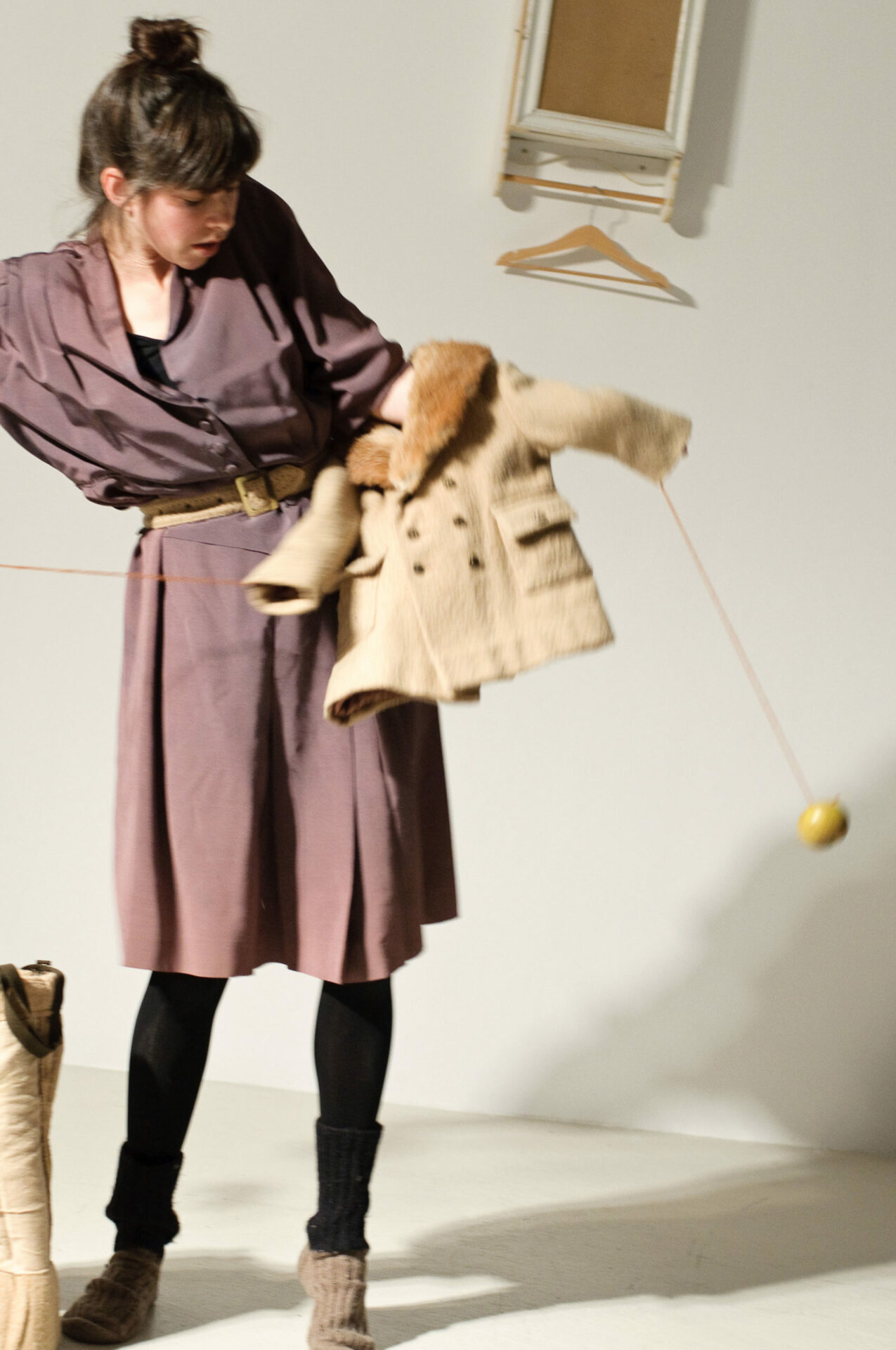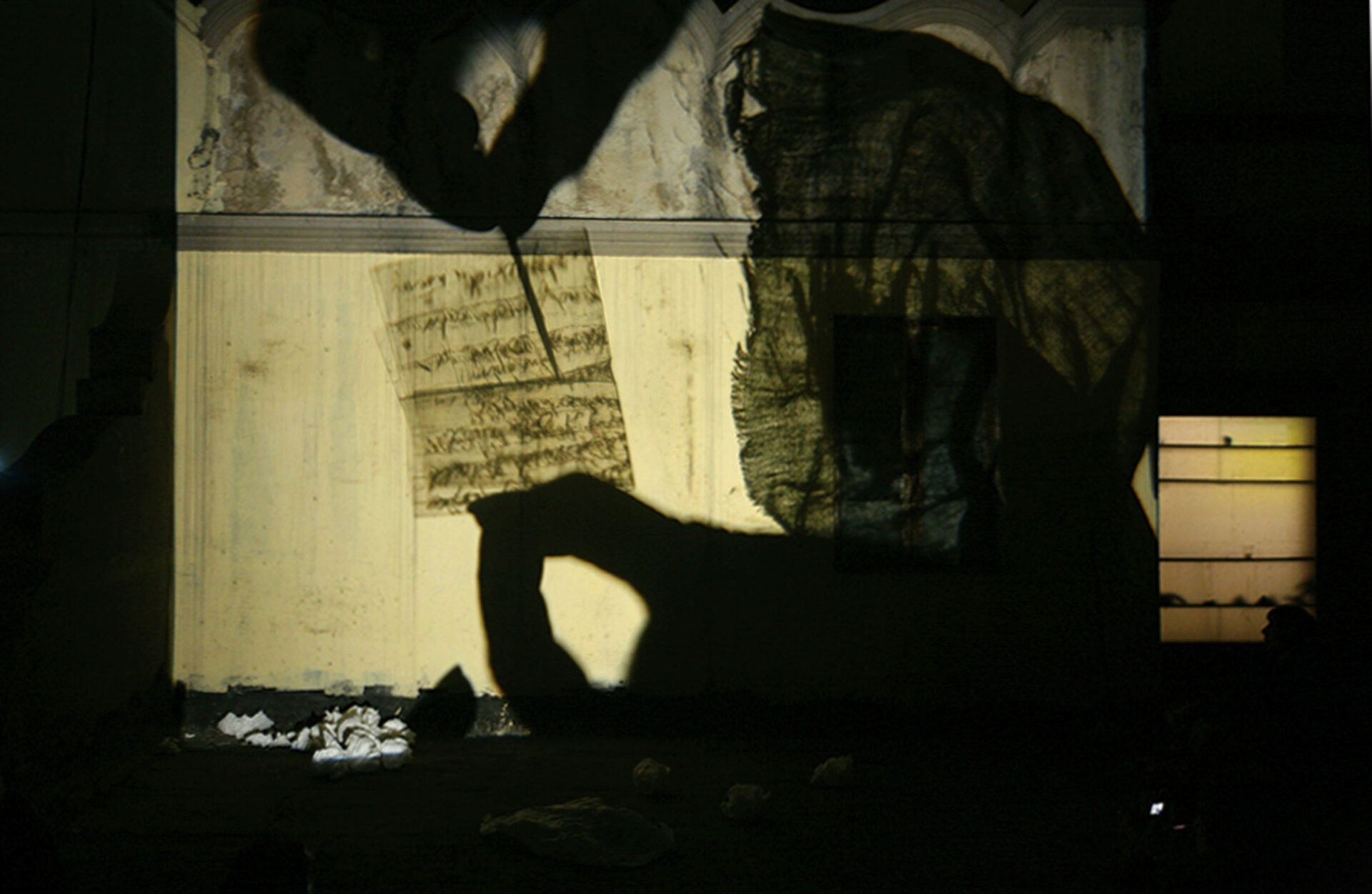
photo : John Sellekaers
Miniaturization is... the cipher of history.
— Giorgio Agamben1 1 - Giorgio Agamben, “Infancy and History,” In Playland (London: Verso, 2007), 81.
Montreal artist Vida Simon’s use of miniature scale proposes the precariousness of intimacy as a form of resistance against the giganticism and publicity of our epoch. In her practice she pursues drawing and installation through performance in which the miniature has the role of opening connections with time past. This occurs through the relationship she establishes to time by way of childhood with its themes of toys and play. In her performances we go behind the scenes to encounter transparency, a sense that we are seeing the really real, the truth-which-is-a-story, a story in which we find ourselves as a collectivity. This is the theatrical dimension of Simon’s performance-installations.
In the installation remaining after the performance A Dream of Ash Teeth (2010) a suit of striped pyjamas, in miniature, has become a toy-like, playful museum artefact, exhibited with numerous worn-down bars of soap placed in a single line. The soap is the actual thing, used, cracked and in various colours. While soap is the main element in the process of cleansing, a ritual activity, seeing it combined with the little striped suit introduces human time, or what we might consider a historical dimension.
Simon’s preferred style of making is the rudimentary; she refuses conventional refinement and “serious” or permanent material along with its monumentality. These factors all contribute to the previously mentioned sense of transparency. Her choices of materials and technique favour simplicity, and her materials include miniature handmade objects constructed with paper, cardboard, glue, paint, thread, bits of fabric, all those sorts of accessible detritus with which one might play. As Walter Benjamin writes, “… in the case of toys simplicity is to be found not in their shapes but in the transparent nature of the manufacturing process.”2 2 - Walter Benjamin, “Toys and Play,” Selected Writings, Vol. 2, Part 1 (Cambridge, Mass.: Belknap Press, 1999), 119.

photo : Vida Simon
At one point in the performance the pyjamas are laid across bars of soap as if the bars were mattresses. At another point the striped pyjamas are supported on a tiny armature, displayed in the style of a museum artefact. The effect would be one of childlike simplicity if it were not for the historical reference. The miniaturization is intertwined with an immensity of meaning, magnified by its indirect path, that of the museum, with displays such as those seen in holocaust museums, childhood visits to which may have been formative for this artist’s memories. The museum experience is an ongoing reference throughout many of Simon’s works and her emphasis on the process of collecting and museological display as a practical relationship with the past brings to mind the works of Martha Fleming and Lyne Lapointe.
The pyjamas in their miniaturization provoke a sense of play, of toys, while the soap speaks of ritual. These two axes, play and ritual, are the friction that gives Simon’s works a notably human dimension. Soap itself is so easily a reference to both friction and repetition as Francis Ponge elaborated on so thoroughly in his poem titled simply Soap, written during the years of the Second World War. Both play and ritual have multiple meanings: “play” might mean the non-purposive and repetitious activity practiced by children, it might mean the activity of players in the theatre, or it might refer to the slack in a mechanical relation. “Ritual” is often the name of an activity empty in itself, a cipher, usually repetitive, as for example, prayer. From an anthropological perspective, ritual’s function is to ensure continuity of experience. In the Benjaminian context, experience means communicable experience of the sort that has disappeared due to the destructive forces of modernization. Giorgio Agamben has added to this the comment that, “It is this non-translatability into experience that now makes everyday existence intolerable. . . it is the character of the present time that all authority is founded on what cannot be experienced.”3 3 - Agamben, op. cit., 16. He refers here to that giganticism and reduction to quantity over quality that characterizes everyday life now so colonized by electronic communications and consumerism.

photos : Vida Simon
One of the great modern theorists of play, the psychoanalyst Donald Winnicott, describes play as “precarious.” This term is provocative, especially if we relate it to Simon’s miniature set of rooms titled Malinas (2007). Like a playhouse, her Malinas is a maquette simply and flimsily improvised from recycled bits of cardboard, fabric and tape. The rooms are open-sided, cutaway, a miniature mise-en-scène (for an imaginary miniature theatrical performance). Typically a theatre set is constructed in advance of the play, whereas in Simon’s performances it is often an outcome of the performance, or the set building is what is played in the performance. It’s intriguing how the two functions overlap through the process of miniaturization, which lends an ambience of secrecy and distance. In any case, the Malinas are tiny sets, stagings of those secret hide-outs used by those hoping to elude the Nazi genocide. What could be more precarious than that sense of waiting for discovery while hiding in a secret compartment, a waiting that in one direction points to memories of that quintessential activity of play while on the other it signals to the worst extremes of fear and destruction.
These maquettes are occupied with detailed furnishings: chairs, rugs, tables, beds with pillows and blankets. Each piece conveys a sense of accuracy to the historical full-sized furniture that they model in miniature. In an abrupt change of scale a “giant” recipe for Borscht rests on a miniature wall: it could be a fragment inserted from the artist’s actual kitchen. Its effect is to heighten the sense of distance implied by miniaturization, but it also contributes to the sense of everydayness. What is large by knowledge but small in perception is distant. The interval is spatial but also implies a distance in time. These sorts of distance are fundamental to the possibility of any sense of intimacy.

photos : John Sellekaers
In the performance titled The Suit (2009) the artist appears in a dress rehabilitated from an earlier era, perhaps fifty or sixty years prior to our time. During the performance, her one “prop” is a child’s suit, a set of outdoor winter clothing also from an earlier era. She has attached one or two balls of wool to the suit and at times appears to engage in repairs to it or perhaps to be un-working it. The overall sense is that the strands of wool are connective threads into the past, and provide what the artist Cecilia Vicuña called, “… sensorial memory, when you touch this particular material it transmits knowledge to the fingers. It is memory of the fingers.”4 4 - Cecilia Vicuña, quoted in “The Memory of The Fingers,” in David Levi-Strauss, From Head to Hand (Oxford: Oxford University Press, 2010), 59.
In many of her performances Simon has used a piece of obsolete pedagogical equipment, the overhead projector. With this she is able to project, on a large scale, images as she makes them, drawing the projected image directly, the production of the drawings being the (temporary) continuity of the performance. Images emerge, and then dissolve, figures appear and disappear into multi-layered constructions demonstrating a sense of memory in its relationship with improvisation. Drawing unfolds in time, recording a gesture against the ready-made and consumable facility of photographic imagery.
“I am thinking about how tiny things can shift our sense of time, that maybe we slow down when looking at something up close that we know was made by hand. This makes me think of care, of delicate things — that I feel we need more experiences of that in the world.” — Vida Simon5 5 - Vida Simon, unpublished letter, 2010.

photo : Jorge Aceituno
For Simon, miniaturization has two spheres of reference: one is memory, the other, history. How this comes about and what happens in the convergence of the two in a particular story is revealed in the “showing how” that the work enacts in a style almost pedagogical. The activity performed is that of playing in both the theatrical sense and that of the children’s pastime. The narrative established is that of demonstration, a “showing how” through a variety of inconsequential practical activities whose real object is “hidden” behind the proffered ostensible object. Paradoxically, what is hidden is the theatrical “showing,” which might, as Benjamin suggests, be called magic.
Play and intimacy are present in many aspects of Simon’s practice due to the fragility of her materials and the ephemerality in its mode of encounter. The bits of faded paper, buttons, walnuts, discarded fabric, dust, tiny boxes, drawers, old clothing, fragments of wood — and other such debris that are her favoured sorts of materials — bear the traces of the past. They could once have functioned as toys, functions that have now generally disappeared through various modernizations, replaced by more efficient procedures.
Vida Simon employs the role of miniature to reflect on the relationship between ritual and play, memory and history, resulting in an art practice that incorporates intimacy and precariousness, thwarting mastery and monumentality in favour of minor practices.
